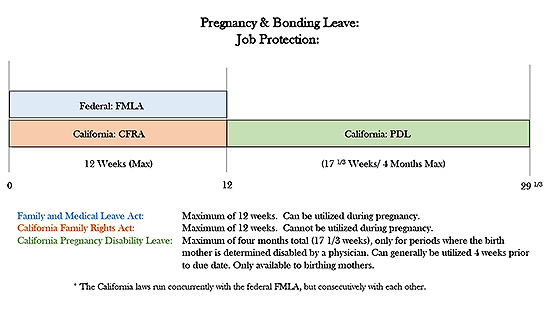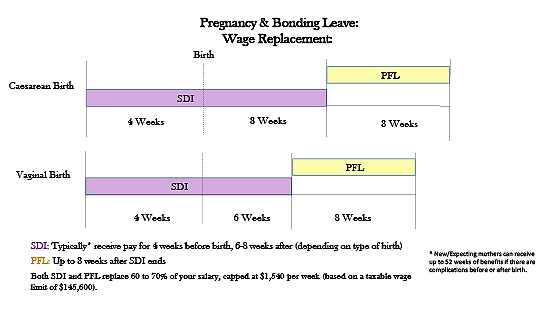Navigating Pregnancy, Parental Leave, and the Return to Work
 Finding out you’re pregnant is perhaps, one of if not the most impactful piece of news a woman can receive. This is particularly so when you work full time – “what does this mean for my job during this pregnancy, once baby is here, and then coming back to work?”
Finding out you’re pregnant is perhaps, one of if not the most impactful piece of news a woman can receive. This is particularly so when you work full time – “what does this mean for my job during this pregnancy, once baby is here, and then coming back to work?”
This article will provide a brief primer for employers and new parents seeking to understand the key provisions of laws and regulations surrounding pregnancy, child bonding leave, and the return to work, under both state and federal law.
Introduction
Part of the barrier to understanding the rights and responsibilities associated with pregnancy and parental leave is that there are several different federal and state laws at play. Further complicating the issue, there is a difference between laws that provide job protection benefits and those that provide wage-replacement benefits. Job protection benefits ensure[1] that an employee will be able to return to the same or a “comparable position” (i.e., one that is “virtually identical” in terms of pay, benefits, working conditions, duties and responsibilities, work site location, and schedules) and also prohibit retaliation or discrimination against an employee for exercising their leave rights – but they do not provide any monetary benefits. Wage replacement benefits, on the other hand, do not provide an employee with any job protection, but are designed to compensate the employee for at least part of their wages while they are on leave. A brief summary of the major laws and regulations:
Job Protection:
Federal Law:
• Family and Medical Leave Act (“FMLA”): Applies to employers with 50 or more employees within a 75-mile radius.
• American with Disabilities Act (“ADA”): Applies to employers with 15 or more employees.
• Pregnancy Discrimination Act (“PDA”): Applies to employers with 15 or more employees
California Law:
• California Family Rights Act (“CFRA”): Applies to employers with 5 or more employees statewide.
• California Pregnancy Disability Leave (“PDL”): Applies to employers with 5 or more employees statewide.
See figure 1.
Wage Replacement:
Federal Law: None
California Law:
• California State Disability Insurance (“SDI”): Applies to employers with 1 or more employees; only available to employees who have earned at least $300 from which SDI deductions were withheld during the base period.
• California Paid Family Leave (“PFL”): Applies to employers with 1 or more employees; only available to employees who have earned at least $300 from which SDI deductions were withheld during the base period.
See Figure 2.
Other counties or cities may have local ordinances that offer paid parental leave benefits as well. For example, San Francisco requires employers with 20 or more employees worldwide to provide up to eight weeks of supplemental compensation to employees who receive California Paid Family Leave benefits to bond with a new child. Check your local ordinances and regulations to see if additional rules apply.
Pregnancy
While pregnant, things may not change a whole lot for you at work, except maybe more people give up their seat while waiting for their cases to be called in the courtroom because you’re noticeably out of breath when you walk through the double doors. Or maybe it’s because you’ve waddled your way down the aisle and the look of exasperation is smeared across your face and everyone wants to help. Perhaps your little one starts playing the drums against your ribs causing you to hit different notes while addressing the judge. In those last few months, you’ll start seeing your doctor more regularly who will take your vitals and determine if you need to be on light duty or certified for 100% disability. It’s important to understand the changes that your body is going through, mentally and physically, so that you can adapt your daily work routine. You need to allow for extra time, extra breaks and the extra appetite that the little human growing inside of you requires.
Job Protection & Accommodations
Under federal law (FMLA), pregnant individuals are entitled to up to 12 weeks of leave due to pregnancy-induced incapacity, including pregnancy complications and morning sickness, or prenatal care. 29 C.F.R. §§ 825.115(b), (f). Similarly, the other parent is also entitled to FMLA leave if they are required to care for a spouse who is pregnant and incapacitated or receiving prenatal care. 29 C.F.R. § 825.120(a)(5)).
Note, however, that employees are only entitled to 12 weeks total during a 12-month period, so any leave taken during the prenatal period will dip into the postnatal bonding time. New parents may choose to use the full 12-weeks for the postnatal period, rather than using their FMLA leave during pregnancy.
Under California law, while CFRA does not consider pregnancy or pregnancy-related disability to be a qualifying health condition, employees can utilize California’s PDL during pregnancy to the extent they are not eligible for FMLA benefits. See Cal. Gov’t Code § 12945; Cal. Code Regs. tit. 2, § 11035(f)). Unlike the FMLA, however, spouses are not eligible for PDL benefits. Generally, doctors certify a pregnant employee as disabled under the PDL four weeks prior to their due date, but if a pregnant employee has complications during pregnancy, a doctor can certify the employee earlier if they deem it medically necessary. Again, any leave taken during pregnancy is counted against the amount of leave available for child bonding, which parents should keep in mind when deciding how to allot their parental leave.
An employer may also be required to provide additional leave as a reasonable accommodation for employees who are experiencing a pregnancy-related disability under the FEHA or the ADA.[2] See Sanchez v. Swissport, Inc. (2013), 213 Cal. App. 4th 1331; Hanson v. Lucky Stores, Inc., (1999) 74 Cal. App. 4th 215, 226 (holding that “a finite leave of absence has been considered to be a reasonable accommodation under ADA”). Importantly, the court in Sanchez held that the right to take leave under the PDL is separate and distinct from the right to take leave under the FEHA, so even where an employee has exhausted their PDL, they may be entitled to additional leave as a reasonable accommodation. Id. at 1338-41.
Pregnant employees may be entitled to other reasonable accommodations as well, such as reduced work schedules, time to attend medical appointments, permission to work from home, the right to use a chair or a water bottle, or more frequent or longer breaks, including bathroom breaks or time to check blood sugar. See, e.g., Cal. Code Regs. tit. 2, §§ 11035, 11040, 11041; ADA, 42 U.S.C. §§ 12101-12213 (providing for reasonable accommodations, including pregnancy-related leave, in circumstances where pregnancy or childbirth complications limit a major life activity). An employee may not be forced to take leave, transfer assignments, or reduce their duties if they do not request it, however. See, e.g., Cal. Code Regs. tit. 2, § 11039(a)(1)(H).
Pregnant employees must be treated the same as non-pregnant employees, and it is illegal to discriminate against them – this includes protections against termination, job refusal, or promotion denial on the basis of pregnancy. See, e.g., PDA, 42 U.S.C. § 2000e(k) (providing no job benefits but making pregnancy discrimination illegal under Title VII of the Civil Rights Act of 1964); Cal. Gov’t Code 12926.1; Cal. Code Regs. tit. 2, § 11064(b); Cal. Gov’t Code § 12926(r)(1).
Wage Replacement
Additionally, individuals experiencing a pregnancy-related disability who are unable to do their normal job duties, as certified by their physician, may receive disability insurance benefits – the usual disability payment for a typical pregnancy begins four weeks prior to the due date (although a physician can certify to a longer disability period if there are medical complications). SDI benefits can provide employees with about 60%-70% of their wages earned (depending on income), ranging from $50 to a maximum of $1,540 per week. The benefit amount may vary if an employee receives other income (such as sick leave pay, paid time off, etc.) simultaneously with the state disability benefits.
Baby Bonding
Until that baby hits your chest in the labor and delivery room, your life has never felt like it had more purpose – and you thought the moment you found out it was starting to grow, life was the most impactful! Every day, every hour brings with it new “best time of your life” moments. People tell you to cherish it now because you can’t get the time back.
But… you have to go back to work. The question though, is when? How long does your employer have to protect your job? The state only gives you six weeks if you had a vaginal birth, and eight weeks if you gave birth by cesarean. Will you be paid enough while on maternity leave? Does your employer even offer maternity leave? Is your employer required to? Did you plan financially for this “vacation?” When the time of your leave comes to an end, you’re expected to hand your baby to someone so that you can return to work. A stranger? Maybe your family can stay home with the little one? Maybe you started interviewing daycare centers before you got pregnant so you feel comfortable handing off that baby so you can head into the office. Regardless of your post-leave plans, the first and most pressing question is: How long are you entitled by law to stay home and bond with your new baby before you return to work?
Job Protection
Under both federal and state law, a new parent may be entitled to unpaid, job-protected leave for bonding with a newborn. The FMLA and CFRA both provide up to 12 weeks of leave in a 12-month period – note, however, that the leave periods run concurrently with each, meaning that an employee cannot stack the leave periods. And any leave taken during pregnancy also counts against the 12 weeks.[3] Either parent may be eligible for leave under the FMLA – not just the birthing parent – and such leave must be concluded within one year from the child’s birth. Cal. Code Regs. tit. 2, § 11090(d); DOL Fact Sheet #28F: Qualifying Reasons for Leave under the Family and Medical Leave Act.
Under California law, new mothers may also be eligible for up to four additional months of PDL leave per pregnancy—this leave runs consecutively with FMLA/CFRA leave, meaning that an employee can stack the leave periods. New mothers may only utilize this leave if they are disabled by childbirth or a related medical condition (Cal. Gov’t Code § 12945(a) and Cal. Code Regs. tit. 2, § 11042(a)). And, as described above, if an employee is disabled for longer than four months because of a pregnancy-related disability, they may be entitled to additional leave under the FEHA or the ADA. See Sanchez, 213 Cal. App. 4th at 1341; 42 U.S.C. § 12112(b)(5)(A); Cal. Gov’t Code § 12940(m).
Wage Replacement
Beginning on the day of a child’s birth (but no later than 41 days after), a new mother can file a claim for postnatal state disability insurance benefits. Before benefits begin, there is a one-week waiting period that is unpaid. Typically, without medical complications, a mother can receive six weeks of partial wage replacement with a vaginal delivery, or eight weeks of partial wage replacement with a cesarean delivery. If there are medical complications due to the birth that prevent the employee from performing their new job duties, however, it is possible for the benefits to be extended for a total of 52 weeks if the disability is certified by a medical practitioner.
In addition to SDI benefits, either parent (including the non-birthing partner) can file for Paid Family Leave benefits, which provide up to eight week of partial wage replacements so that new parents can bond with a new child during the child’s first year.
Both the SDI and PFL benefits provide about 60-70% of an employee’s earnings (depending on income), ranging from $50 to a maximum of $1,540 per week. Employees may qualify even if they are seasonal, part time, or unemployed. Eligibility is based on whether the employee has paid into California SDI in the preceding 5-18 months. Self-employed employees may also be eligible if they contribute to the Disability Insurance Elective Coverage program.
Return to Work
Now, lucky you! You get to come to work and do double duty, mind and body. Your mind is on your cases while your body continues to work to produce food for the new baby. Now you’ll need to pump during your busy day; maybe you can multi-task and catch a nap while you do it! The trick to this part is figuring out the schedule that best suits your baby’s needs – how many ounces a day does the baby need to eat? How often do your breasts fill and become engorged? Maybe you aren’t emptying each time you pump, and you get mastitis.
So many things go into being a new mother while also working full time – you realize you’re working many more jobs than just two and every minute counts.
New parents returning from protected leave have the right to be reinstated to the same or a comparable position. An employer may not retaliate against an employee returning from parental leave, including, for example, by reassigning them to a less favorable position, reducing their pay, or providing a pretextual negative performance evaluation.
In addition to the right to be reinstated to the same or a comparable position, new parents might require accommodations upon their return to work, which the employer should grant so long as they: (1) are reasonable; (2) are recommended by the employee’s health care practitioner; and (3) would not cause an undue burden on the employer. Such accommodations could include requesting intermittent leave, or a reduced work schedule, although those accommodations may affect an employee’s PDL/CFRA leave allocation. See, e.g., Cal. Code Regs. tit. 2, § 11040(b).
Finally, both the FLSA and the California Labor Code require employers to provide lactation breaks. Cal. Lab. Code § 1030; 29 U.S.C. § 207(r). Federal and state law also prohibit employers from discriminating or retaliating against new mothers based on lactation or expression of milk. 42 U.S.C. § 2000e; Cal. Gov’t Code §§ 12926(r)(1)(C) and 12940.
In addition to providing lactation breaks, employers are also required to provide a room or other location (NOT a bathroom) where the employee can express breast milk in private. There are several requirements the lactation room must meet, including that it must:
• Be in close proximity to the employee’s work area;
• Be shielded from view;
• Be free from intrusion while the employee is expressing milk;
• Be safe, clean, and free of hazardous materials;
• Must contain a surface to place a breast pump and personal items;
• Must provide a place to sit; and
• Must have access to electricity or alternative devices, such as extension cords or charging stations, that are needed to operate an electric or battery-powered breast pump.
Cal. Lab. Code § 1031 (b)-(c). Employers are also required to provide the employee access to both a sink with running water and a refrigerator (or other cooler or suitable cooling device) in which their milk can be stored. Id. at (d).
Conclusion
Navigating pregnancy and new parenthood can be complicated enough without the stress of trying to understand your rights and benefits. Hopefully this guide has provided a helpful starting point for your journey. For any additional questions, please contact an employment law attorney.
[1] The right to return is not completely absolute – it may be lawful to deny an employee reinstatement under limited circumstances that are unrelated to the employee’s decision to exercise their leave rights (such as a layoff resulting from a plant closure) (Cal. Code Regs. tit. 2, § 11043(c)(1)).
[2] Note that pregnancy itself, absent particular complications, is not by itself considered a disability under the ADA.
[3] However, because CFRA does not consider pregnancy to be a qualifying health condition, leave taken pursuant to a pregnancy related disability counts only toward FMLA and PDL; consequently, if an employee were to exhaust their FMLA and PDL during pregnancy, they would still be entitled to CFRA leave to bond with their newborn.
MCLE Self Study
Earn one hour of Elimination of Bias MCLE credit by answering the questions on the Self Study MCLE test available here.
Send your answers along with a check (430 per credit hour for CCCBA members/$45 per credit hour for non members) to the address on the test form. Certificates are processed within two weeks of receipt. If you prefer to receive the test form via email, contact Anne K. Wolf at awolf@cccba.org or (925) 370-2540.

